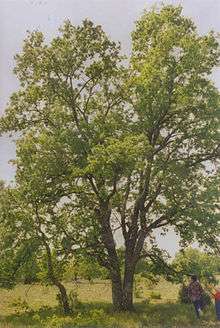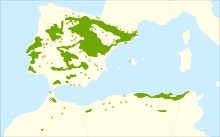Quercus faginea
Quercus faginea, the Portuguese oak or Valencian oak, is a species of oak native to the western Mediterranean region in the Iberian Peninsula and the Balearic Islands. Similar trees in the Atlas Mountains of northwest Africa are usually included in this species, or sometimes treated as a distinct species Quercus tlemcenensis. It occurs in mountains from sea level to 1900 m altitude, and flourishes in a variety of soils and climates.
| Portuguese oak | |
|---|---|
 | |
| Scientific classification | |
| Kingdom: | Plantae |
| Clade: | Tracheophytes |
| Clade: | Angiosperms |
| Clade: | Eudicots |
| Clade: | Rosids |
| Order: | Fagales |
| Family: | Fagaceae |
| Genus: | Quercus |
| Subgenus: | Quercus subg. Quercus |
| Section: | Quercus sect. Quercus |
| Species: | Q. faginea |
| Binomial name | |
| Quercus faginea | |
 | |
| Distribution map | |
| Synonyms[1] | |
| |
Q. faginea is a medium-sized deciduous or semi-evergreen tree growing to 20 m tall, with a trunk up to 80 cm in diameter, with grey-brown bark. The tree can live as long as 600 years. The leaves are 4–10 cm long and 1.2–4.0 cm broad (rarely to 15 cm long and 5 cm broad), glossy dark green to grey-green above, and variably felted grey-white below; the margins have five to 12 pairs of irregular teeth. Leaf fall is typically in mid- to late winter. The flowers are catkins, produced between March and April, almost always before holm oak, which grows in similar areas. The acorns are oblong-ovoid, 2.0–2.5 cm long, maturing in 6 months to disperse in September or October.[2][3][4]
The species commonly develops galls due to gall wasp activity; the galls are brown, 1–2 cm diameter, and have a spongy, cork-like interior.[5]
The two subspecies are:
- Q. f. subsp. faginea - Iberian Peninsula
- Q. f. subsp. broteroi (Cout.) A.Camus (syn. Q. tlemcenensis) - Northwest Africa and Southwest of the Iberian Peninsula
Portuguese oak also hybridises readily with other related oaks such as Algerian oak (Q. canariensis) and downy oak (Q. pubescens), which can make identification difficult.
The specific name faginea refers to the superficial resemblance of the leaves to those of the beech (Fagus).
Uses
The wood has been used traditionally as firewood and as timber for construction (beams and posts). The acorns, like those of the cork oak, are an important food for free-range black Iberian pigs reared for jamón ibérico production. It is also occasionally planted as an ornamental tree.
References
- "Quercus faginea Lam.". World Checklist of Selected Plant Families (WCSP). Royal Botanic Gardens, Kew – via The Plant List.
- "Quercus faginea". Flora Europaea. Edinburgh: Royal Botanical Garden. 2008.
- Bean, W. J. (1976). Trees and shrubs hardy in the British Isles 8th ed., revised. John Murray.
- Rushforth, K. (1999). Trees of Britain and Europe. HarperCollins ISBN 0-00-220013-9.
- CAB International (2005). data on Quercus faginea, Forestry Compendium Archived October 9, 2007, at the Wayback Machine. Retrieved 27 July 2006.
External links
- Jean Louis Helardot, Chênes: Quercus faginea (in French)
| Wikimedia Commons has media related to Quercus faginea. |